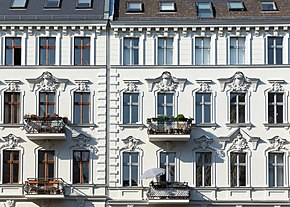Bergmannkiez
The Bergmannkiez is a location in the Berlin district of Kreuzberg . In some cases, the location at Chamissoplatz is also delimited as Chamissokiez.
location
It is named after the centrally located Bergmannstrasse , around which there is a homogeneous residential area with many preserved buildings from the period before 1900 . In the north, the Gneisenaustrasse and the Landwehr Canal as far as the Südstern form the neighborhood boundaries. The western boundary is the Mehringdamm . The houses on Schwiebusser Strasse and Jüterboger Strasse in the southern area are part of it, which means that Columbiadamm forms a structural boundary. To the east, the cemeteries on Bergmannstrasse limit the Bergmannkiez to other quarters.
Originally located in front of the southern city wall of Berlin, the area with the surrounding Tempelhofer Vorstadt was incorporated into Berlin in 1861. The area, which up until then had been largely used for agriculture, was developed as planned: residential and commercial areas were created next to the railway systems and various military objects ( barracks , training areas). The proximity to Berlin led to the settlement of many excursion restaurants, some of whose tradition has been preserved into the 21st century, which made the area famous throughout the city. The center on Marheinekeplatz is the Passion Church and Market Hall XI . Popular weekly and flea markets take place on the square as well as on the nearby Chamissoplatz .
Streets
Overview
Fidicin Street
This west-east traffic route between Mehringdamm (in the 19th century: Belle-Alliance-Strasse ) and Friesenstrasse was named in 1890 in honor of the city archivist and historian Ernst Fidicin . To supply the new residents of Kreuzberg with drinking water, the city administration had a water tower built on the corner of Kopischstrasse , which went into operation in 1888. The windmill that stood opposite him on today's property at Fidicinstrasse 10 was torn down a little later in favor of residential development.
On the site between Fidicinstrasse 2/3 and Schwiebusser Strasse, which runs parallel to the south, the Berlin Bock brewery settled in around 1840 . The listed buildings have not been used as a brewery since the 1920s, but a dance school, a piano workshop, a wine store, a drum school and the archive of youth cultures were temporarily located there. Due to development plans, the site was gradually de-let from 2017.
Initially, bakers, shoemakers, butchers and cigar and coal traders found space for their services in the ground floor areas of the rental houses along the street. Today there are cafes and restaurants as well as other businesses and apartments on the ground floors. The multi-storey town houses were supplemented by transverse and courtyard wings, so that up to 30 tenants were often named under one house number.
Roadside vegetation found only sporadically in this busy and popular residential street. Most of the residents of the Wilhelminian style buildings, which were well restored in the 21st century and hardly destroyed in World War II , are now families with children. After 1961, the families of Turkish guest workers temporarily dominated .
Infrastructure
The neighborhood is accessed by four underground stations on the U6 and U7 lines:
- Gneisenaustraße underground station ,
- Mehringdamm underground station ,
- Platz der Luftbrücke underground station ,
- Südstern underground station .
There are also facilities
- the Berlin Police Directorate V,
- the Berlin vehicle registration office,
- of the main customs office in Berlin.
Cultural institutions are among others
- the English Theater Berlin ,
- the Columbiahalle ,
- the archive of youth cultures.
Architectural monuments

- Ensemble Chamissoplatz with tenement houses, commercial center and water tower
- Arndtstrasse: “ Café Achteck ” (public lavatory) from 1895 on the corner of Chamissoplatz
- Bergmannstrasse: the 133rd and 149th community dual school, No. 28/29 (1884/1985); the 60th and 236th Community School, No. 60/64/65 (1901/1902); Abspannwerk (1929–1931) No. 5–7
- Friesenstrasse: Barracks of the Queen Augusta Guard Grenadier Regiment No. 4 and the Guard Cuirassier Regiment (1895–1897)
- Kopischstraße No. 7: Water Tower (1886–1888)
Web links
- Carmen Schucker: 10 reasons for the Bergmannkiez. In: Der Tagesspiegel , May 14, 2013
Individual evidence
- ↑ Fidicinstrasse 2/3 . In: Address book for Berlin and its suburbs , 1900, 3, p. 149.
- ↑ Marcus Weingärtner: "I wouldn't leave here anymore" . In: Berliner Zeitung , 5./6. March 2016, p. 16.
